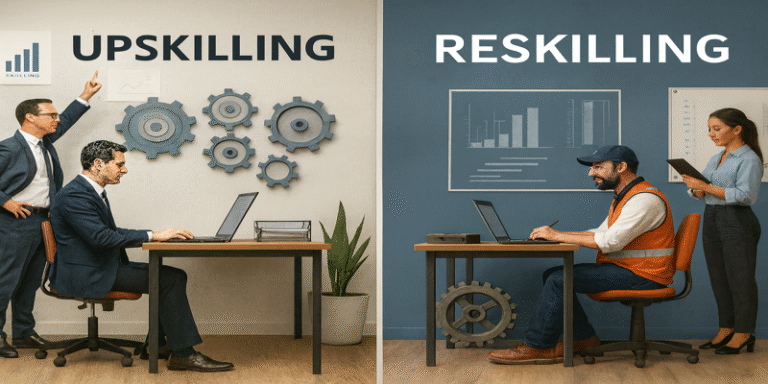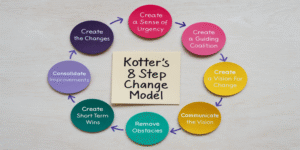In today’s dynamic job market, the ability to adapt is critical. Two strategies gaining increasing importance are upskilling and reskilling. While both involve learning new skills, they serve distinct purposes: upskilling enhances capabilities within an existing profession, whereas reskilling prepares individuals to transition into new roles or industries.
As technological innovation, automation, and economic shifts reshape labour demands, investing in upskilling and reskilling is vital for long-term career sustainability.
1.0 Upskilling: Enhancing Existing Competencies
Definition
Upskilling refers to improving or acquiring additional skills relevant to one’s current field. It ensures professionals stay aligned with evolving industry standards, technologies, and practices (Lewis, 2017).
Objective
The goal of upskilling is to deepen expertise in a specific role, thereby increasing efficiency, competitiveness, and career mobility. As industries modernise, employees must integrate emerging tools—such as artificial intelligence (AI) and machine learning—into daily workflows (McKinsey & Company, 2020).
Example
A software engineer learning cloud computing or DevOps tools exemplifies upskilling. By doing so, they boost their effectiveness, contribute to team agility, and become eligible for leadership roles.
Why Upskilling Matters
Research by Deloitte (2019) found that 84% of employees believe upskilling improves career resilience. Key benefits include:
- Keeping pace with change: Rapid tech innovation demands updated competencies.
- Higher productivity: Mastery of new tools can reduce task time and error rates.
- Job security: Skilled workers are less vulnerable to redundancy.
- Career growth: Upskilling opens opportunities for promotions or cross-functional roles.
Effective Upskilling Strategies
- Identify in-demand skills: Use platforms like LinkedIn or reports from HBR and Deloitte to spot trending skills (Bersin, 2021).
- Pursue microlearning: Short online courses, certifications, or webinars provide accessible knowledge.
- Apply learning immediately: Practice solidifies learning and signals capability to employers (ILO, 2020).
🔎 Example: A financial analyst may upskill in data visualisation tools like Tableau or Python to generate automated insights.
2.0 Reskilling: Transitioning to New Career Paths
Definition
Reskilling involves learning entirely new skill sets for a career change or industry shift. It often addresses job displacement caused by automation or market realignment (World Economic Forum, 2020).
Objective
The aim is to bridge skill gaps so individuals can enter growing fields such as renewable energy, digital marketing, or data analytics (European Commission, 2020).
Example
An administrative assistant who reskills in digital marketing—learning content creation, SEO, and social media management—can pivot into a high-demand sector, leveraging transferable skills like organisation and communication.
Why Reskilling Is Critical
The rise of automation is displacing certain roles, especially in sectors like retail and manufacturing. Bessen (2019) noted that demand for jobs shifts with the development of new technologies. Reskilling offers:
- Employment continuity: Shifts workers from declining to expanding sectors.
- Increased employability: Trained candidates in new technologies appeal to forward-thinking employers.
- Adaptability: Builds resilience for future workforce disruptions.
Effective Reskilling Strategies
- Conduct market research: Identify industries with talent shortages or growth projections.
- Map transferable skills: Many abilities—like problem-solving or customer service—apply across domains.
- Formal training: Enrol in bootcamps, diplomas, or government-sponsored schemes to build new qualifications (ILO, 2020).
🧠 Example: A hospitality worker learns coding and UX design to join the tech industry—leveraging people skills in product user testing.
3.0 The Role of Employers in Upskilling and Reskilling
Employers increasingly recognise the need to future-proof their workforce. In fact, Accenture (2020) reports that organisations investing in employee learning see stronger performance and innovation.
Ways companies contribute:
- Internal training programmes: Workshops, mentorships, and career academies.
- Learning platforms: Access to Coursera, LinkedIn Learning, or internal LMS portals.
- Career coaching: Helps employees chart development plans.
Governments and institutions like the European Commission (2020) are also supporting lifelong learning through funding, public-private partnerships, and digital skills initiatives aligned with the green and digital economy.
🌍 Example: In Sweden, employers receive government grants to train employees at risk of automation-related displacement.
4.0 Choosing Between Upskilling and Reskilling
Determining whether to upskill or reskill depends on your current industry’s stability, your career goals, and the skills gap you face.
| Scenario | Strategy | Reason |
| Industry is evolving, but still stable | Upskilling | Enhances performance in a growing role |
| Role is becoming automated | Reskilling | Prepares for career shift to future-proof job |
| You want a promotion in your field | Upskilling | Develops leadership or technical depth |
| You want to enter a new industry | Reskilling | Aligns competencies with new sector requirements |
5.0 Lifelong Learning as a Professional Mindset
The modern workforce requires a shift from one-time education to continuous professional development. The World Economic Forum (2020) estimates over 1 billion people will require upskilling or reskilling by 2030.
Employing a lifelong learning mindset enables individuals to:
- Stay agile in uncertain job markets
- Take ownership of their careers
- Access higher-quality employment options
Whether learning through YouTube, university short courses, podcasts, or peer mentoring, professionals who invest in their growth are better equipped to adapt, lead, and succeed.
In an era marked by disruption, both upskilling and reskilling are indispensable tools for career advancement. While upskilling enhances performance within a current role, reskilling opens new pathways into future-ready careers.
The choice between them hinges on individual career objectives and industry trends. By employing strategic learning, engaging in market research, and leveraging support from employers and governments, individuals can ensure they remain competitive and relevant in an ever-changing workforce.
Organisations also benefit by nurturing agile talent, enhancing innovation, and securing their future in a tech-driven economy. Ultimately, those who commit to lifelong learning will thrive amid ongoing change.
References
Accenture (2020) Investing in People: Why Upskilling and Reskilling are Vital for Future Success. [Online] Available at: https://www.accenture.com [Accessed 19 Oct. 2024].
Bersin, J. (2021) ‘The Definitive Guide to Upskilling in the Workforce’, Harvard Business Review. [Online] Available at: https://hbr.org [Accessed 19 Sept. 2024].
Bessen, J. (2019) ‘AI and Jobs: The Role of Demand and Wages’, Journal of Economic Perspectives, 33(2), pp. 39–56.
Deloitte (2019) Global Human Capital Trends 2019: Leading the Social Enterprise. [Online] Available at: https://www2.deloitte.com [Accessed 19 Sept. 2024].
European Commission (2020) Skills for Jobs: Upskilling and Reskilling in the EU. [Online] Available at: https://ec.europa.eu [Accessed 19 Sept. 2024].
International Labour Organisation (ILO) (2020) Upskilling and Reskilling for the Future of Work. [Online] Available at: https://www.ilo.org [Accessed 19 Sept. 2024].
Lewis, M. (2017) ‘Upskilling for Success in the Digital Economy’, Journal of Digital Transformation, 5(4), pp. 25–34.
McKinsey & Company (2020) The Future of Work in Europe: Automation, Workforce Transitions, and Growth. [Online] Available at: https://www.mckinsey.com [Accessed 19 Sept. 2024].
World Economic Forum (2020) The Future of Jobs Report 2020. [Online] Available at: https://www.weforum.org [Accessed 19 Sept. 2024].









